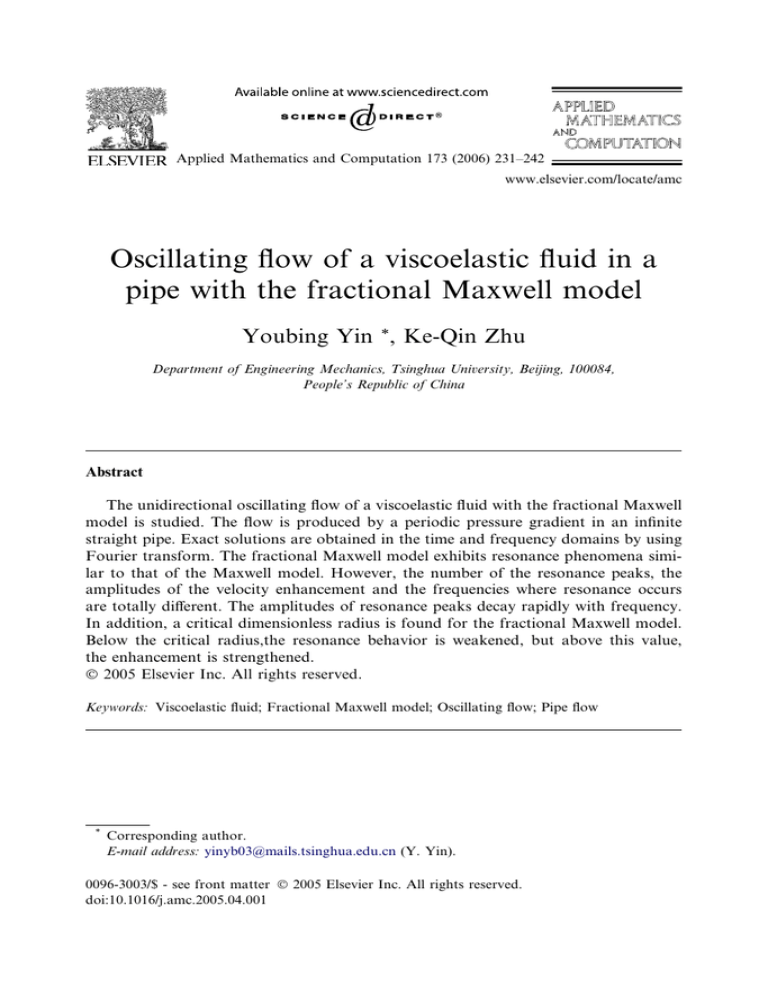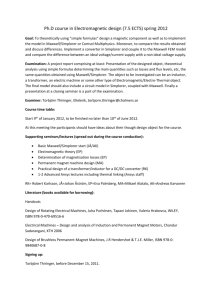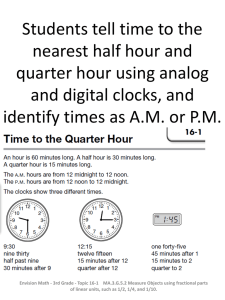
Applied Mathematics and Computation 173 (2006) 231–242
www.elsevier.com/locate/amc
Oscillating flow of a viscoelastic fluid in a
pipe with the fractional Maxwell model
Youbing Yin *, Ke-Qin Zhu
Department of Engineering Mechanics, Tsinghua University, Beijing, 100084,
People’s Republic of China
Abstract
The unidirectional oscillating flow of a viscoelastic fluid with the fractional Maxwell
model is studied. The flow is produced by a periodic pressure gradient in an infinite
straight pipe. Exact solutions are obtained in the time and frequency domains by using
Fourier transform. The fractional Maxwell model exhibits resonance phenomena similar to that of the Maxwell model. However, the number of the resonance peaks, the
amplitudes of the velocity enhancement and the frequencies where resonance occurs
are totally different. The amplitudes of resonance peaks decay rapidly with frequency.
In addition, a critical dimensionless radius is found for the fractional Maxwell model.
Below the critical radius,the resonance behavior is weakened, but above this value,
the enhancement is strengthened.
Ó 2005 Elsevier Inc. All rights reserved.
Keywords: Viscoelastic fluid; Fractional Maxwell model; Oscillating flow; Pipe flow
*
Corresponding author.
E-mail address: yinyb03@mails.tsinghua.edu.cn (Y. Yin).
0096-3003/$ - see front matter Ó 2005 Elsevier Inc. All rights reserved.
doi:10.1016/j.amc.2005.04.001
232
Y. Yin, K.-Q. Zhu / Appl. Math. Comput. 173 (2006) 231–242
1. Introduction
Investigation of oscillating flow in a pipe has many applications in various
branches of science. In the field of bio-engineering, this type of investigation is
of particular interest since blood in veins is forced by a periodic pressure gradient. In the petroleum and chemical industries, there are also many problems
which involve the dynamic response of the fluid to the frequency of the periodic
pressure gradient. In these fields, however, the fluids, such as blood, oil, and
polymer solution, not only have the viscosity of the fluid, but also exhibit
the elasticity of the solid. These kinds of fluids are often treated as viscoelastic
fluids. Because of the difficulty to suggest a single model which exhibits all
characteristic of viscoelastic fluids, there exist many viscoelastic models and
constitutive equations. Among those the Maxwell model is the simplest one.
It is constructed by the series of the spring and dashpot and can qualitatively
reflect some properties of the viscoelastic fluid, such as stress relaxation.
During the past few years, attention has been given to the study on oscillating flow of viscoelastic fluids in a pipe [1–4]. In those studies, the Maxwell
model was adopted to describe the viscoelastic fluid. Rahaman et al. [1] analyzed some kinds of basic unsteady pipe flows of viscoelastic fluid with Maxwell
model, including periodic oscillation flow. They obtained the exact solutions
and analyzed the velocity profile. Andrienko et al. [2] also studied the unidirectional oscillating flow of viscoelastic fluid with the Maxwell model in a tube,
and they found that the instantaneous velocities drastically increase at certain
frequencies of the oscillating pressure gradient and called this phenomenon as
the resonance-like behavior of viscoelastic fluids. In addition, Rio et al. [3]
studied the flow of a Maxwell fluid in a tube under the oscillating pressure gradient in order to analyze the effects of elasticity on the dynamics of fluids in
porous media. They gave an analytical expression for the dynamic permeability
and showed that a dramatic enhancement at certain frequencies occurred.
Based on Rios research [3], Tsiklauri et al. [4] studied the similar problem
while considering the longitudinal vibration of the wall of the tube. The transition from a dissipative regime to an elastic regime was found in their research.
However, the Maxwell model is a linear model for viscoelastic fluids and it is
proper only under the condition that non-linear effects are negligible, such as
very low strain and stress. The model also leads to an exponential stress relaxation modulus; for real materials, however, the stress relaxation obeys an algebraic decay [5]. Recently, fractional calculus has encountered much success in
the description of viscoelasticity [6–9]. The fractional derivative models with
the algebraic stress decay can be easily constructed. And the fractional Maxwell model is one among these fractional models. Experimental research has
shown that a better agreement of the experimental data could be achieved with
the fractional Maxwell model than the ordinary Maxwell model [6]. With this
mind, Tan et al. [10] studied four unsteady flows of a viscoelastic fluid with the
Y. Yin, K.-Q. Zhu / Appl. Math. Comput. 173 (2006) 231–242
233
fractional Maxwell model between two infinite parallel plates. Hayat et al. [11]
also took the fractional Maxwell model into account and discussed three types
of unidirectional flows which were induced by general periodic oscillations of a
plate.
The purpose of this paper is to discuss the unidirectional oscillating flow of a
viscoelastic fluid. The flow is produced by a period pressure gradient in an infinite straight pipe. Although there are many literatures on this problem [1–4],
here we consider the fractional Maxwell model to describe the viscoelastic fluid.
First, we introduce the construction of the fraction model for the viscoelastic
fluid. Then we give the governing equations on this problem. By using the Fourier transform, we obtain the exact solutions of the flow in the time and frequency domains. Based on the solution in the time domain, we define the
velocity enhancement as the ratio of the amplitude of oscillating velocity on
the axis of the tube to the velocity when the pressure is constant. We discuss
further the velocity enhancement of the factional Maxwell model using two
pairs of fractional parameters, which are obtained from a experimental research in [6].
2. Construction of the fractional model for the viscoelastic fluid
There are two methods to construct the fractional model [5]. The direct one
is to replace the time derivatives of an integer order by the Riemann–Liouville
fractional calculus operators. For example, the fractional Maxwell model can
be constructed through the replacement
r þ ka
da r
db e
¼ Ekb b ;
a
dt
dt
ð1Þ
where r is the shear stress, e is the shear strain, E is a shear modulus, k = l/E is
a relaxation time, l is the constant viscosity coefficient, and a and b are fractional parameters which satisfy 0 < a < 1, 0 < b < 1. This approach is very simple, but its physical meaning is ambiguous. The models must be determined
after further analysis. For example, the restriction of a 6 b must be given in
Eq. (1) to satisfy the physical meaning.
In the following, we give the second method which is able to guarantee that
the fractional models obtained through it are physically correct.
First, we introduce the stress–strain relation with fractional-order derivative
[12]
dc e
; ð0 < c < 1Þ
dtc
t c
E
;
GðtÞ ¼
Cð1 cÞ k
rðtÞ ¼ Ekc
ð2Þ
ð3Þ
234
Y. Yin, K.-Q. Zhu / Appl. Math. Comput. 173 (2006) 231–242
where G(t) is the relaxation modulus which has the algebraic form and C(Æ) is
the Gamma function. This model is also known as Scott–Blairs model, and it
can be realized physically through hierarchical arrangements of springs and
dashpots, such as ladders, trees and so on. We can also interpret the model
as an interpolation between Hookes law (c = 0) and Newtons law (c = 1).
In order to construct the fractional model, we introduce the fractional element defined as the mechanical elements which obey Eq. (2). A fractional element is determined by three parameters (c, E, k) and is symbolized by a triangle,
as shown in Fig. 1(c). In the following, we will treat a fractional element as the
same status as a spring and a dashpot which are shown in Fig. 1(a) and (b) to
construct the viscoelastic models.
We carry out a proper generalization of the ordinary Maxwell model, which
is depicted in Fig. 2(a). We simply replace the two classical elements by fractional elements with the parameters (c1, E1, k1) and (c2, E2, k2) in Fig. 2(b).
µ
E
b
a
(γ,E,λ)
c
Fig. 1. Single elements: (a) elastic element; (b) viscous element and (c) fractional element.
(γ1,E1,τ1)
E
(γ2,E2,τ2)
η
a
b
Fig. 2. (a) The classical Maxwell model and (b) the fractional Maxwell model.
Y. Yin, K.-Q. Zhu / Appl. Math. Comput. 173 (2006) 231–242
235
The fractional elements obey the stress–strain relations: r1 ðtÞ ¼
E1 kc11 dc1 e1 ðtÞ=dtc1 and r2 ðtÞ ¼ E2 kc22 dc2 e2 ðtÞ=dtc2 . Due to the series connection
of the elements, it is easy to obtain
c
rðtÞ þ
c1
E1 k11 dc1 c2 rðtÞ
c1 d eðtÞ
¼
E
k
.
1
c2
1
dtc1
E2 k2 dtc1 c1
ð4Þ
Without loss of generality, we can assume c1 > c2. Eq. (4) can be further simplified by introducing new variables
k ¼ ðE1 kc11 =E2 kc22 Þ1=c1 c2 ;
E ¼ E1 ðk1 =kÞc1
ð5Þ
and this leads to
rðtÞ þ kc1 c2
c1
dc1 c2 rðtÞ
c1 d eðtÞ
¼
Ek
;
dtc1 c2
dtc1
ð6Þ
which is the constitutive equation of the fractional Maxwell model. If we replace c1c2 and c1 with a and b, respectively, we can get the same equation
as Eq. (1)
r þ ka
da r
db e
¼ Ekb b .
a
dt
dt
ð7Þ
So it is obvious that the condition a 6 b must be imposed in Eq. (7) because
c1 c2 is always less than c1 for c1 P 0 and c2 P 0.
A further advantage for the second method is that the procedure is much
easier to understand through a generalization of the classical viscoelastic
model. With the similar procedure, we can construct other fractional models,
such as the fractional Voigt model and so on.
3. Governing equations and analytical solutions
The unidirectional oscillating flow of a viscoelastic fluid in an infinite
straight pipe with the radius of a under a periodic pressure gradient is studied.
The viscoelastic fluid is described by the incompressible fractional Maxwell
model.
The constitutive equation for the fractional Maxwell model is give in Eq. (7).
It can be seen that this model includes the classical Maxwell model as a special
case for a = b = 1 and the Newtonian fluid model when a = 0, b = 1.
Following the rules of fractional calculus [13], Eq. (7) can be rewritten as
follows:
r þ ka
da r
db1 e_
¼ Ekb
;
a
dtb
dt
where e_ is the shear rate.
ð8Þ
236
Y. Yin, K.-Q. Zhu / Appl. Math. Comput. 173 (2006) 231–242
For the incompressible flow, the continuity equation is
div~
u¼0
ð9Þ
and the momentum equation, in the absence of body forces, is
q
D~
u
~ þ div~
¼ rp
s;
Dt
ð10Þ
where ~
u; q; p; ~
s refer to the velocity vector, density, pressure and stress tensor,
respectively. D/Dt denotes the material derivative.
We construct the cylindrical coordinate system (r, h, z) and make the z-axis
direct along the axis of the tube. For the problem under consideration here, the
velocity field has only z directional component, i.e.
~
u ¼ uz ðr; tÞ~
ez ;
ð11Þ
where ~
ez is the unit vector in the z direction. And only the rz component of the
stress tensor is non-zero. Then the constitutive equation (8) becomes
rrz þ ka
b1
da rrz
ouz
b d
¼
Ek
dta
dtb1 or
ð12Þ
and meanwhile, the momentum equation (10) and no-slip boundary condition
read
ouz
op oðrrrz Þ
¼ þ
oz
ror
ot
uz ða; tÞ ¼ 0.
q
ð13Þ
ð14Þ
From Eqs. (12) and (13), we can obtain the governing equation for uz as
follows:
a b1
ouz op
ouz op
o
ouz
a d
b d
r
q
þ þk a q
þ
¼ Ek
.
ð15Þ
oz
oz
ot
dt
ot
rdtb1 or
or
Let the pressure gradient oscillate with frequency x and amplitude P0, i.e.
op
¼ P 0 eixt
ð16Þ
oz
and we assume that all physical quantities vary in time as eixt. In order to solve
Eq. (15), we define the Fourier transform of the velocity uz and pressure p
Z 1
uz ðr; tÞeixt dt;
ð17Þ
U z ðr; xÞ ¼
1
P ðz; xÞ ¼
Z
1
pðz; tÞeixt dt
1
and the Fourier transform for the fractional derivative is given by [13]
ð18Þ
Y. Yin, K.-Q. Zhu / Appl. Math. Comput. 173 (2006) 231–242
Z
db ½uz ðr; tÞ ixt
b
e dt ¼ ðixÞ U z ðr; xÞ;
dtb
1
bp
bp
b
b ibp=2 sign x
b
¼ jxj cos þ i sign x sin
;
ðixÞ ¼ jxj e
2
2
237
1
ð19Þ
ð20Þ
where sign x is the sign function.
Transforming Eqs. (14) and (15), we get
U z ða; xÞ ¼ 0;
oU z
a
a oP
b1 o
a
a
b
¼ Ek ðixÞ
r
qðixÞð1 þ k ðixÞ ÞU z þ ð1 þ k ðixÞ Þ
.
oz
ror
or
ð21Þ
ð22Þ
Solving Eq. (22) under the boundary condition (21), we can get the velocity
solution in the frequency domain
i oP
J 0 ðnrÞ
1
U z ðr; xÞ ¼
;
ð23Þ
qx oz
J 0 ðnaÞ
where the parameter n is determined from
n2 ¼ qð1 þ ka ðixÞa Þ
Ekb ðixÞ
b2
¼
a
q þ qka jxj cos ap
þ i sign x sin ap
2
2
b2
ðb2Þp
Ekb jxj
cos ðb2Þp
þ
i
sign
x
sin
2
2
ð24Þ
and J0 is the zeroth-order Bessel function. If we take a = b = 1 and replace x
with x , the same solution as in [3] can be obtained.
Using the inverse Fourier transform to Eq. (23), we can get the solution of
the velocity in the time domain
i op
J 0 ðnrÞ
1
uz ðr; tÞ ¼
.
ð25Þ
qx oz
J 0 ðnaÞ
Substituting the expression of the pressure gradient of Eq. (16), we arrive at
iP 0
J 0 ðnrÞ ixt
1
uz ðr; tÞ ¼
ð26Þ
e .
J 0 ðnaÞ
qx
We introduce the dimensionless parameters
pffiffiffiffiffiffiffiffiffi
~ ¼ xk; ~t ¼ t=k
~
u ¼ uz =u0 ; ~r ¼ r= ðmkÞ; x
and
-¼
1 þ ðixkÞ
ðixkÞb2
a
~ a cos ap
~ sin ap
1 þ jxj
þ i sign x
2
2
;
¼
ðb2Þp
~ b2 cos ðb2Þp
~
jxj
þ
isign
x
sin
2
2
ð27Þ
ð28Þ
where u0 = P0a2/(4l) is the velocity at ~r ¼ 0 when the pressure gradient is constant and equal to P0, i.e.dp/dx = P0. Besides, it should be noted that the
238
Y. Yin, K.-Q. Zhu / Appl. Math. Comput. 173 (2006) 231–242
physical condition of k > 0 is used in Eq. (28). Thus, we can get the dimensionless form of Eq. (26)
pffiffiffiffi 4i
J 0 ð -~rÞ ix~~t
pffiffiffiffi
~
u¼ 2
ð29Þ
e .
1
J 0 ð -~
aÞ
~
~
ax
We also introduce enhancement Au defined as the amplitude of dimensionless velocity on the axis of the tube in Eq. (29). It can be obtained as follows:
4i
1
.
pffiffiffiffi
ð30Þ
Au ¼ 2
1
~
J ð -aÞ ~
~
ax
0
Note that the enhancement Au denotes the ratio of the amplitude of the velocity on the center axis under oscillating pressure gradient P0eixt to that under
the constant pressure gradient P0.
4. Results and discussion
It has been mentioned that the fractional Maxwell model will be simplified
to the ordinary Maxwell model for a = b = 1. The variations of the velocity
enhancement Au for the Maxwell model are given at four dimensionless radii
of e
a ¼ 0.05; e
a ¼ 0.1; ~
a ¼ 0.5 and ~
a ¼ 5 in Fig. 3(a)–(d), respectively. It can
2500
a
600
2000
500
1500
400
b
300
1000
200
500
100
20 40 60 80 100 120 140
25
20 40 60 80 100 120 140
c
d
0.8
20
0.6
15
0.4
10
0.2
5
20 40 60 80 100 120 140
20 40 60 80 100 120 140
~ (x-axis) for the
Fig. 3. Velocity enhancement Au (y-axis) versus the dimensionless frequency x
Maxwell model when: (a) ~a ¼ 0.05; (b) ~a ¼ 0.1; (c) ~a ¼ 0.5 and (d) ~a ¼ 5.
Y. Yin, K.-Q. Zhu / Appl. Math. Comput. 173 (2006) 231–242
239
be seen from these figures that drastic enhancements of the velocity amplitude
occur at certain frequencies, which are the so-called resonance phenomena. For
a fixed dimensionless radius ~
a in any figure of Fig. 3(a)–(d), we can observe that
the amplitude of the enhancement decreases as the frequency increases and the
largest enhancement occurs at the smallest resonance frequency. But if the
dimensionless radius grows, the number of the resonance peaks in the same frequency region increases, meanwhile the magnitude of the peak and the resonance frequency with the same order decreases. With further increase in the
dimensionless radius, the curve even becomes monotonous and has no peaks,
as shown in Fig. 3(d). A detailed discussion about this part can be obtained
from [2].
Real viscoelastic fluids can be exactly described by the fractional Maxwell
models. Here we will take two polymers [6], i.e. PTFE (Polytetrafluorethylene)
and PMMA (Methylmethacrylate) for example to discuss the results of the
fractional model. The fractional parameters of these polymers are a = 0.0357,
b = 0.0520 (PTFE) and a = 0.5865, b = 0.6921 (PMMA), respectively. In Figs.
4 and 5, we give the curves of velocity enhancement Au versus dimensionless
~ at four dimensionless radii ((a) ~
frequency x
a ¼ 0.05, (b) ~a ¼ 0.1, (c) ~a ¼ 0.5,
(d) ~
a ¼ 5) for these two polymers, respectively.
Figs. 4 and 5 show that the resonance phenomena similar to the Maxwell
model also exist in the case of the fractional Maxwell model. The similar laws
1200
a
600
1000
500
800
400
600
300
400
200
200
100
20 40 60 80 100 120 140
120
c
b
20 40 60 80 100 120 140
12
d
10
100
80
8
60
6
40
4
20
2
20 40 60 80 100 120 140
20 40 60 80 100 120 140
~ (x-axis) for the
Fig. 4. Velocity enhancement Au (y-axis) versus the dimensionless frequency x
fractional Maxwell model with a = 0.0357, b = 0.0520 when: (a) ~a ¼ 0.05; (b) ~a ¼ 0.1; (c) ~a ¼ 0.5
and (d) ~
a ¼ 5.
240
Y. Yin, K.-Q. Zhu / Appl. Math. Comput. 173 (2006) 231–242
a
80
b
150
60
100
40
50
20
20 40 60 80 100 120 140
12
c
20 40 60 80 100 120 140
1
d
10
0.8
8
0.6
6
4
0.4
2
0.2
20 40 60 80 100 120 140
20 40 60 80 100 120 140
~ (x-axis) for the
Fig. 5. Velocity enhancement Au (y-axis) versus the dimensionless frequency x
fractional Maxwell model with a = 0.5865, b = 0.6921 when: (a) ~a ¼ 0.05; (b) ~a ¼ 0.1; (c) ~a ¼ 0.5
and (d) ~
a ¼ 5.
which are mentioned for the Maxwell model also can be observed. First, if the
dimensionless radius is fixed, the largest enhancement occurs at the smallest
resonance frequency and the amplitude of the enhancement decreases as the
frequency increases. Second, as the dimensionless radius grows, the number
of the resonance peaks in the same frequency region increases, but the magnitude of the peak and the resonance frequency with the same order decrease.
The curve can even become monotonous once the dimensionless radius is large
enough.
However, some differences between the classical Maxwell model and the
fractional Maxwell model can also be observed from Figs. 3–5.
First, it can be seen that the number of the resonance peaks in the same frequency region, the amplitudes of the enhancement and the frequencies where
resonance occurs are totally different for these two models through the comparison between the figures with the same radius in Figs. 3–5.
Furthermore, we can see that the amplitudes of resonance peaks for the fractional models given by Figs. 4 and 5 decay more quickly as the frequency grows
than those of the Maxwell model in Fig. 3. For the fractional Maxwell model,
the peaks except the first one is so low that they can be neglected, namely, the
first resonance peak is the most important. Take the cases of the dimensionless
radius ~
a ¼ 0.05 in Figs. 3(a) and 4(a) for an example. For the classical Maxwell
model, the first peak value is about 2500 and the second one is above 1500 yet.
Y. Yin, K.-Q. Zhu / Appl. Math. Comput. 173 (2006) 231–242
241
However, for the fractional model with the parameters a = 0.0357, b = 0.0520,
the first peak value is near 2300 but the second one is only slightly larger than
500.
In addition, we can find that a critical dimensionless radius exists for the
fractional models. Below the critical radius, both the amplitudes of resonance
peaks and the number of pikes in the same frequency region are less than those
of the classical Maxwell model, namely, the resonance behavior for the fractional Maxwell model is weakened. However, above this value, the first peak
value for the fractional model is much higher and the number of the peaks increases compared with the case of the classical Maxwell model, namely, the
enhancement is strengthened. The critical value is about ~ac ¼ 0.095 for the
fractional Maxwell model with parameters a = 0.0357, b = 0.0520 and about
~
ac ¼ 1.3 for parameters a = 0.5865, b = 0.6921.
5. Conclusions
In this paper, we analyze the unidirectional oscillating flow of a viscoelastic
fluid in an infinite straight pipe. A fractional Maxwell model is considered. Exact solutions are obtained in the time and frequency domains by using Fourier
transform. Based on the exact solutions, we discuss the velocity enhancement
of the fractional Maxwell model in detail through the comparison between
the fractional Maxwell model and the classical Maxwell model.
We observe that the resonance phenomenon similar to the Maxwell model
also exists in the case of the fractional Maxwell model. There exists some similar laws as follows: (1) For a fixed dimensionless radius, the amplitude of the
enhancement decreases as the frequency increases, and the largest enhancement
occurs at the smallest resonance frequency. (2) If the dimensionless radius
grows, the number of the resonance peaks in the same frequency region increases, but the magnitude of the peak and the resonance frequency with the
same order decrease. (3) The curve will become monotonous once the dimensionless radius is large enough.
However, there are also some differences between these two models. (1) The
number of the resonance peaks in the same frequency region, the amplitudes of
the enhancement and the frequencies where resonance occurs are totally different. (2) For the fractional, the amplitudes of resonance peaks models decay
rapidly with frequency and only the first resonance peak is primary. (3) A critical dimensionless radius exists for the fractional models. Below the critical
radius, the resonance behavior is weakened, but above this value, the enhancement is strengthened.
Through the analysis above, we find that although there are some similarities between the fractional Maxwell model and the classical Maxwell model in
describing the pipe oscillating flow, there are also distinct differences. Recently,
242
Y. Yin, K.-Q. Zhu / Appl. Math. Comput. 173 (2006) 231–242
the research has shown that the fractional models can describe the real viscoelastic fluids better than the classical linear models. So we can expect that the
results presented in this paper will be of importance to the fundamental research in this area and its practical applications.
Acknowledgement
The authors are very grateful for the support of SRFDP under Grant No.
20040003070.
References
[1] K.D. Rahaman, H. Ramkissoon, Unsteady axial viscoelastic pipe flows, J. Non-Newtonian
Fluid Mech. 57 (1995) 27–38.
[2] Yu.A. Andrienko, D.A. Siginer, Yu.G. Yanovsky, Resonance behavior of viscoelastic fluids in
Poiseuille flow and application to flow enhancement, Int. J. Non-Linear Mech. 35 (2000) 95–
102.
[3] J.A. del Rio, M. Lpez de Haro, S. Whitaker, Enhancement in the dynamic response of a
viscoelastic fluid flowing in a tube, Phys. Rev. E 58 (1998) 6323–6327.
[4] David Tsiklauri, Igor Beresnev, Enhancement in the dynamic response of a viscoelastic fluid
flowing through a longitudinally vibrating tube, Phys. Rev. E 63 (2001) 046304.
[5] R. Hilfer, Applications of Fractional Calculus in Physics, World Scientific Press, Singapore,
2000.
[6] A. Hernández-Jiménez, J. Hernández-Santiago, A. Macias-Garcı́a, J. Sánchez-González,
Relaxation modulus in PMMA and PTFE fitting by fractional Maxwell model, Polym. Test.
21 (2002) 325–331.
[7] Y.S. Dao, Q.J. Ti, Study on the constitutive equation with fractional derivative for the
viscoelastic fluids—modified Jeffreys model and its application, Rheol. Acta 37 (1998) 512–517.
[8] Y.A. Rossikhin, M.V. Shitikova, A new method for solving dynamic problems of fractional
derivative viscoelasticity, Int. J. Eng. Sci. 39 (2001) 149–176.
[9] L.I. Palade, P. Attane, R.R. Huilgol, B. Mena, Anomalous stability behavior of a properly
invariant constitutive equation which generalises fractional derivative models, Int. J. Eng. Sci.
37 (1999) 315–329.
[10] W. Tan, W. Pan, M. Xu, A note on unsteady flows of a viscoelastic fluid with the fractional
Maxwell model between two parallel plates, Int. J. Non-Linear Mech. 38 (2003) 645–650.
[11] T. Hayat, S. Nadeem, S. Asghar, Periodic unidirectional flows of a viscoelastic fluid with the
fractional Maxwell model, Appl. Math. Comput. 151 (2004) 153–161.
[12] G.S. Blair, The role of psychophysics in rheology, J. Colloid Sci. 1 (1947) 21–33.
[13] Igor Podlubny, Fractional Differential Equations, Academic Press, USA, 1999.









